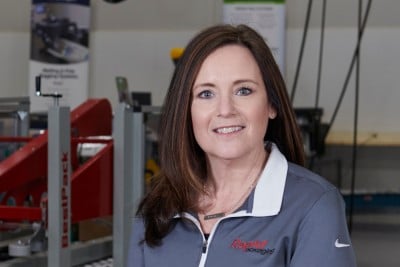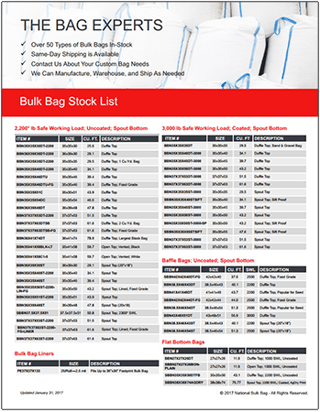For many different products and applications specialty bags like coated FIBCs and FIBCs with pre-installed liners are required for safe bulk bag use. However, how do you know when to use a lined bag? Or when to use a coated bag? We get asked this question a lot at National Bulk Bag so we attempt to answer that question in this blog post.
FIBC Liners
Poly liners are plastic liners inserted into FIBCs and provide protection against leaking. They are often used in situations where fine powders are being stored and transported or an additional moisture barrier is needed to add protection to the product.
They are often a great fit for the food and pharmaceutical industries because when combined with a multi-use bag (6:1 safety ratio) they can easily be removed from the FIBC, discarded and replaced with a new liner allowing the bulk bag to be re-used. This is one of the primary reasons to use a poly liner instead of a bulk bag with a pre-installed liner.
Lined Bulk Bags
As described earlier in this post, companies can purchase poly liners for bulk bags and insert them into pretty much any FIBC. However, you can also purchase bags that come with liners already built into the woven polypropylene. The advantage to buying bulk bags with liners installed is the many options you have. There are 4 main types of lined FIBCs that we outline in this article. Having these different options allows lined bags to be used with a greater variety of products and applications.
The largest disadvantage to using pre-lined bags is that the liners are usually either sewn into the seams of the bag or tabbed to the bag’s material and cannot be removed. This offers slightly less flexibility for re-use when compared to using removable poly liners.
Coated Bulk Bags
A coated FIBC is constructed similarly to a standard FIBC, however, before the bag is sewn together, an additional polypropylene film is added to the bag’s fabric sealing the small gaps in the poly weaves. This film can be added to the inside or outside of the bag.
Inside application is the most common because it can keep products like powders from getting stuck in the weave when discharged. The coating can be difficult to detect if you’re not very familiar with flexible intermediate bulk containers. The easiest way to tell if a fabric is coated is to press the weave together to see if it spreads apart. Make sure to test both the outside and inside of the bag. If the weave does not spread apart, there’s a good chance the bag is coated.
The biggest benefit of a coated bag is the additional protection it offers the materials being stored and/or transported. FIBCs are often used in environments where outside contaminants like dust, moisture, and dirt can be a factor. The coating on a bag can provide an added layer of protection.
Common uses for coated bags:
- When you’re transporting dry flow-able products in powder, crystal, granule or flake form such as cement, detergents, flour, salt, fine minerals such as carbon black, sand and sugar
- At times, a poly liner may be used along with a coated bag to add an extra layer of protection.
When to Use a Liner/Coated/Lined Bulk Bag
Like most decisions involving what bulk bag to use when, deciding between a poly liner, lined bag, and coated bag comes down to product and application. Coated bags don’t offer as much protection against outside contamination as lined bags and poly liners. However, they are a very economical option.
If you’re looking for more protection, or are using bulk bags with very fine powders, poly liners and bags that come with liners built in are the best option. This is due to the nature of woven polypropylene. Fine powders can seep through the woven strands making standard and coated bags ineffective with these products.
When deciding between removable poly liners and bags that come with liners pre-installed, the decision comes down to two important factors: if you’re going to be re-using the bag(s) and/or if you need a specialty liner (aluminum foil, lay-flat, baffle, or form fit). Removable liners only come in a standard polypropylene design, so if you need a specialty liner for your product or application, your best option is a bag that comes with a built in liner. If you’d like to re-use your bulk bag with a different product or application, a removable poly liner is the best option. Removable liners allow you to simply remove the used poly liner after use, discard it, and put a new one in. You’re now ready to use your FIBC in a different product and/or application.
Thanks for Reading!
Thanks for reading our post on four common uses for FIBC bulk bag liners! We hope you found this post both helpful and informative.
Finding the right bulk bag polyethylene liner for your product and application can be difficult. Not only is it important to determine the right type of liner for your product and application, it is imperative that you also determine the correct size of liner for the specific bag you are using.
To accurately determine what size polyethylene liner is right for the bag you are using or are interested in, download our FIBC Bulk Bag Liner Estimation Calculator by clicking the button below!






